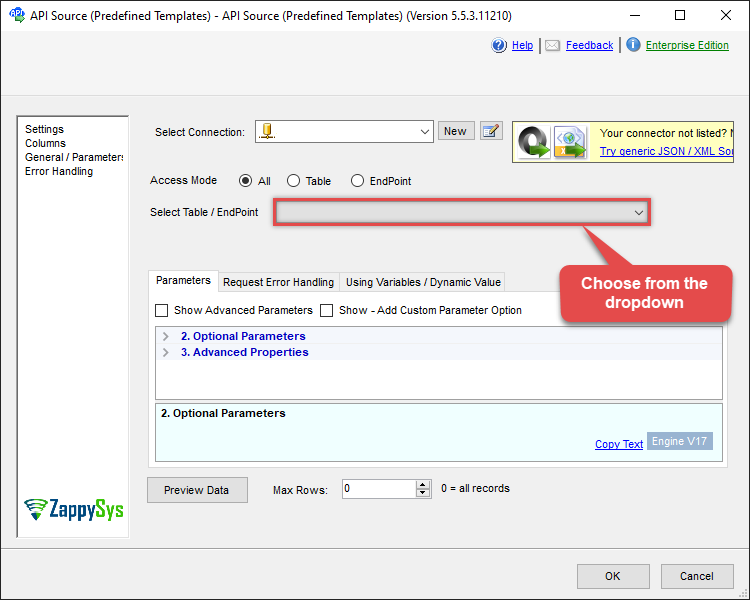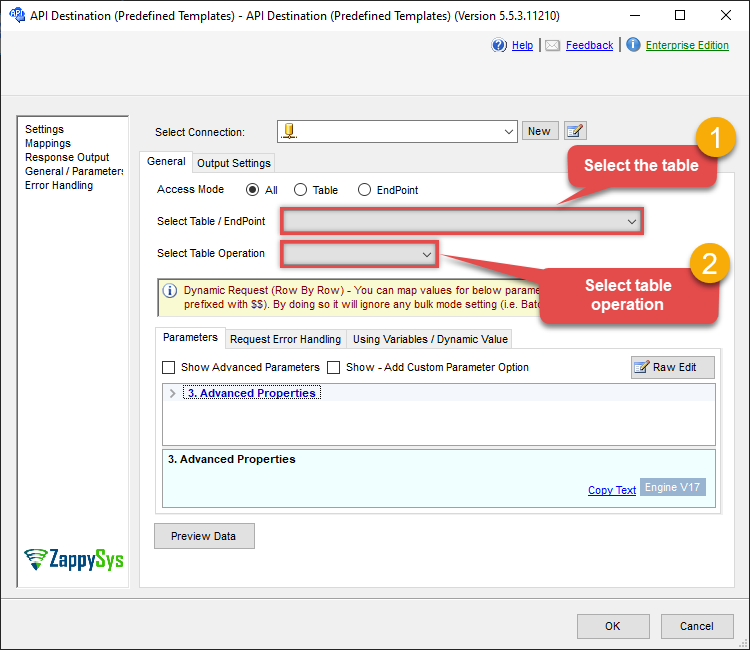Endpoint Get Group by Id
Name
get_group
Description
Get a specific group. [API reference]
Related Tables
Parameters
| Parameter | Required | Options |
|---|---|---|
|
Name:
Label: Group ID or Email The Microsoft Mail group ID GUID or email address for the account to read messages from. (Examples: '4ff54a77-9c09-4274-958f-83bdc0a53900' or 'sales@domain.com') |
YES |
Output Columns
| Label | Data Type (SSIS) | Data Type (SQL) | Length | Description |
|---|---|---|---|---|
| Id |
DT_WSTR
|
nvarchar(500)
|
500 | |
| DisplayName |
DT_WSTR
|
nvarchar(500)
|
500 | |
| DeletedDateTime |
DT_WSTR
|
nvarchar(500)
|
500 | |
| Classification |
DT_WSTR
|
nvarchar(500)
|
500 | |
| CreatedDateTime |
DT_DBTIMESTAMP
|
datetime
|
||
| CreationOptions |
DT_WSTR
|
nvarchar(1470)
|
1470 | |
| Description |
DT_WSTR
|
nvarchar(1000)
|
1000 | |
| ExpirationDateTime |
DT_WSTR
|
nvarchar(500)
|
500 | |
| GroupTypes |
DT_WSTR
|
nvarchar(500)
|
500 | |
| IsAssignableToRole |
DT_BOOL
|
bit
|
||
DT_WSTR
|
nvarchar(500)
|
500 | ||
| MailEnabled |
DT_BOOL
|
bit
|
||
| MailNickname |
DT_WSTR
|
nvarchar(100)
|
100 | |
| MembershipRule |
DT_WSTR
|
nvarchar(500)
|
500 | |
| MembershipRuleProcessingState |
DT_WSTR
|
nvarchar(500)
|
500 | |
| OnPremisesDomainName |
DT_WSTR
|
nvarchar(500)
|
500 | |
| OnPremisesLastSyncDateTime |
DT_WSTR
|
nvarchar(500)
|
500 | |
| OnPremisesNetBiosName |
DT_WSTR
|
nvarchar(500)
|
500 | |
| OnPremisesSamAccountName |
DT_WSTR
|
nvarchar(500)
|
500 | |
| OnPremisesSecurityIdentifier |
DT_WSTR
|
nvarchar(500)
|
500 | |
| OnPremisesSyncEnabled |
DT_WSTR
|
nvarchar(500)
|
500 | |
| PreferredDataLocation |
DT_WSTR
|
nvarchar(500)
|
500 | |
| PreferredLanguage |
DT_WSTR
|
nvarchar(500)
|
500 | |
| ProxyAddresses |
DT_WSTR
|
nvarchar(4000)
|
4000 | |
| RenewedDateTime |
DT_DBTIMESTAMP
|
datetime
|
||
| ResourceBehaviorOptions |
DT_WSTR
|
nvarchar(1020)
|
1020 | |
| ResourceProvisioningOptions |
DT_WSTR
|
nvarchar(500)
|
500 | |
| SecurityEnabled |
DT_BOOL
|
bit
|
||
| SecurityIdentifier |
DT_WSTR
|
nvarchar(1000)
|
1000 | |
| Theme |
DT_WSTR
|
nvarchar(500)
|
500 | |
| UniqueName |
DT_WSTR
|
nvarchar(500)
|
500 | |
| Visibility |
DT_WSTR
|
nvarchar(100)
|
100 | |
| OnPremisesProvisioningErrors |
DT_WSTR
|
nvarchar(50)
|
50 | |
| ServiceProvisioningErrors |
DT_WSTR
|
nvarchar(50)
|
50 |
Input Columns
| Label | Data Type (SSIS) | Data Type (SQL) | Length | Description | |||||||||||||||||||||||||||||||||||||||||||||||||||||||||||||||||||||||||||||||||||||||||||||||
|---|---|---|---|---|---|---|---|---|---|---|---|---|---|---|---|---|---|---|---|---|---|---|---|---|---|---|---|---|---|---|---|---|---|---|---|---|---|---|---|---|---|---|---|---|---|---|---|---|---|---|---|---|---|---|---|---|---|---|---|---|---|---|---|---|---|---|---|---|---|---|---|---|---|---|---|---|---|---|---|---|---|---|---|---|---|---|---|---|---|---|---|---|---|---|---|---|---|---|---|
| There are no Static columns defined for this endpoint. This endpoint detects columns dynamically at runtime. | |||||||||||||||||||||||||||||||||||||||||||||||||||||||||||||||||||||||||||||||||||||||||||||||||||
Examples
SSIS
Use Outlook Mail (Office 365) Connector in API Source or in API Destination SSIS Data Flow components to read or write data.
API Source
This Endpoint belongs to the Groups table, therefore it is better to use it, instead of accessing the endpoint directly:
| Required Parameters | |
|---|---|
| Group ID or Email | Fill-in the parameter... |

API Destination
This Endpoint belongs to the Groups table, therefore it is better to use it, instead of accessing the endpoint directly. Use this table and table-operation pair to get group by id:
| Required Parameters | |
|---|---|
| Group ID or Email | Fill-in the parameter... |

ODBC application
Use these SQL queries in your ODBC application data source:
Get group by id
SELECT * FROM Groups
WHERE Id = 'abcd-1234-groupid'
get_group endpoint belongs to
Groups
table(s), and can therefore be used via those table(s).
SQL Server
Use these SQL queries in SQL Server after you create a data source in Data Gateway:
Get group by id
DECLARE @MyQuery NVARCHAR(MAX) = 'SELECT * FROM Groups
WHERE Id = ''abcd-1234-groupid''';
EXEC (@MyQuery) AT [LS_TO_OUTLOOK_MAIL_OFFICE_365_IN_GATEWAY];
get_group endpoint belongs to
Groups
table(s), and can therefore be used via those table(s).
